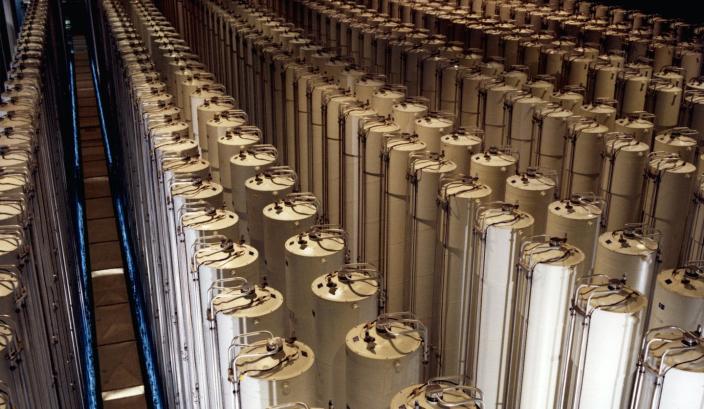Iran’s nuclear program is a major topic in President Joe Biden’s meetings this week with leaders in the Middle East. The most challenging part of producing nuclear weapons is making the material that fuels them, and Iran is known to have produced uranium that is near-weapons grade.
The Conversation asked Brandeis University professor Gary Samore, who worked on nuclear arms control and nonproliferation in the U.S. government for over 20 years, to explain why uranium enrichment is central to Iran’s nuclear ambitions and where the Iranian effort stands now.
What does it mean to enrich uranium?
Natural uranium contains two main isotopes, or forms whose atoms contain the same number of protons but different numbers of neutrons. It’s about 99.3% uranium-238 and 0.7% uranium-235. The uranium-235 isotope can be used to generate nuclear power for peaceful purposes, or nuclear explosives for military purposes.
Enrichment is the process of separating out and increasing the concentration of U-235 to higher levels above natural uranium. Generally speaking, lower levels of enriched uranium, such as uranium with 5% U-235, are commonly used for nuclear reactor fuel. Higher levels of enrichment, such as 90% U-235, are most desirable for nuclear weapons.
For military purposes, why are higher levels of enrichment important?
The higher the level of enrichment, the smaller the amount of nuclear material necessary to produce a nuclear weapon.
The International Atomic Energy Agency identifies 25 kilograms (55 pounds) of 90% enriched uranium as a “significant quantity” necessary for a simple nuclear weapon. But larger amounts of lower-enriched uranium can also work.
For example, the “Little Boy” atomic bomb that the U.S. dropped on Hiroshima, Japan, in 1945 used about 64 kilograms of uranium (141 pounds) enriched to an average of 80% U-235.
From a nuclear weapons design standpoint, smaller amounts of higher-enriched nuclear material are more desirable because that reduces the size and weight of the nuclear weapon and makes it easier to deliver. As a result, modern nuclear weapons based on uranium typically use uranium enriched to 90% to 93% U-235, which is known as weapons-grade uranium, for the primary fuel.
What had Iran achieved prior to the 2015 nuclear deal?
The 2015 nuclear deal between Iran, the U.S. China, France, the United Kingdom, Russia and Germany put significant restrictions on Iran’s nuclear program, in return for relief from a number of international sanctions. When the deal was adopted, Iran had mastered the basic technology for enriching uranium with gas centrifuges – cylinders that spin uranium in gas form at very high speeds to separate the heavier U-238 isotope from the lighter U-235 isotope.
At its two principal enrichment facilities, Natanz and Fordow, Iran was operating about 18,000 first-generation IR-1 centrifuges and about 1,000 second-generation IR-2 centrifuges. It had also accumulated a stockpile of roughly 7,000 kilograms (about 15,430 pounds) of low-enriched uranium (under 5%) and about 200 kilograms (440 pounds) of 20% enrichment uranium.
Based on these capabilities, Iran’s “breakout time” to produce about 25 kilograms (55 pounds) of 90% enriched uranium – enough for a single nuclear weapon – was estimated to be one or two months.
Breakout time is not intended to suggest that Iran would necessarily decide to produce weapons-grade uranium at these inspected facilities, because the risk of detection and of potential negative international reaction is very high.
How did the nuclear deal constrain Iran’s activities?
The 2015 nuclear deal put physical constraints on Iran’s enrichment program for 10 to 15 years, including the number and type of centrifuges Iran could operate, the size of its stockpile of low-enriched uranium and its maximum enrichment level.
For 15 years, no enrichment would take place at Fordow, and Iran’s stockpile of low-enriched uranium would be limited to 300 kilograms (660 pounds) at a maximum enrichment level of 3.67%. And for 10 years, its centrifuges would be limited to about 6,000 IR-1 centrifuges at Natanz.
In order to meet these physical limits, Iran shipped out to Russia most of its stockpile of low-enriched uranium and its entire stockpile of 20% enriched uranium. It also dismantled for storage inside Iran most of its IR-1 centrifuges and all of its more advanced IR-2 centrifuges. As a consequence of these limits, Iran’s “breakout time” was extended from a month or two before the deal to about one year after the deal.
After year 10 of the deal, however, Iran was allowed to start replacing its IR-1 centrifuges at Natanz with more advanced models, which it was permitted to continue to research and develop during the first decade of the deal. As these more powerful advanced centrifuges were installed, breakout time would probably have shrunk to about a few months by year 15 of the deal.
As part of the deal, Iran also agreed to enhanced international inspections and monitoring of its nuclear facilities.
What has Iran done since President Trump withdrew the U.S. from the nuclear deal in 2018?
Since the U.S. withdrew from the nuclear deal, Iran has gradually exceeded the agreement’s limits. It has increased its stockpile of 5% enriched uranium; resumed producing 20% enriched uranium; initiated production of 60% enriched uranium, resumed enrichment at Fordow; and manufactured and installed advanced centrifuges at both Natanz and Fordow.
Iran has also begun to restrict international monitoring of its nuclear facilities. In June 2022, for example, Iran announced that it was disconnecting cameras installed under the 2015 nuclear deal to monitor its nuclear facilities.
[embedded content]
As of May 2022, the International Atomic Energy Agency estimated that Iran had about 1,000 kilograms (2,200 pounds) of 5% enriched uranium, about 240 kilograms (530 pounds) of 20% enriched uranium and 40 kilograms (88 pounds) of 60% enriched uranium.
As a result of this growing stockpile of enriched uranium and the use of advanced centrifuges, Iran’s estimated breakout time has been reduced to a few weeks. So far, however, Iran has not decided to begin production of weapons-grade (90%) enriched uranium, even though it is technically capable of doing so.
Most likely, Iran is behaving cautiously because its leaders are concerned that producing weapons-grade uranium would trigger a strong international reaction, which could range from additional sanctions to military attack.
This article is republished from The Conversation, a nonprofit news site dedicated to sharing ideas from academic experts. It was written by: Gary Samore, Brandeis University.
Read more:
Gary Samore Samore previously served as President Barack Obama’s White House Coordinator for Arms Control and Weapons of Mass Destruction (WMD) and President Bill Clinton’s Senior Director for Non-proliferation and Export Controls.





